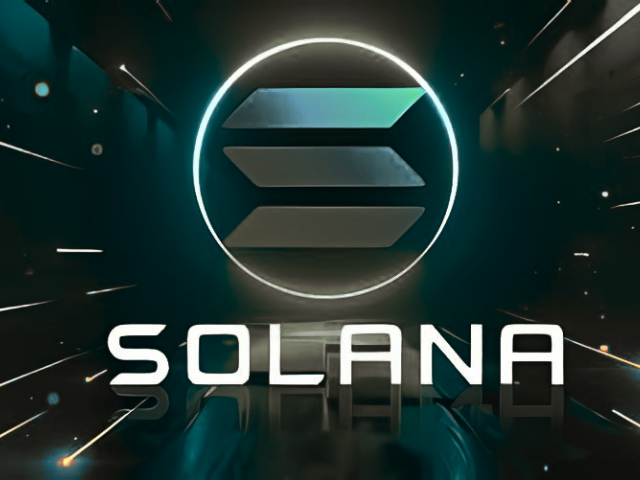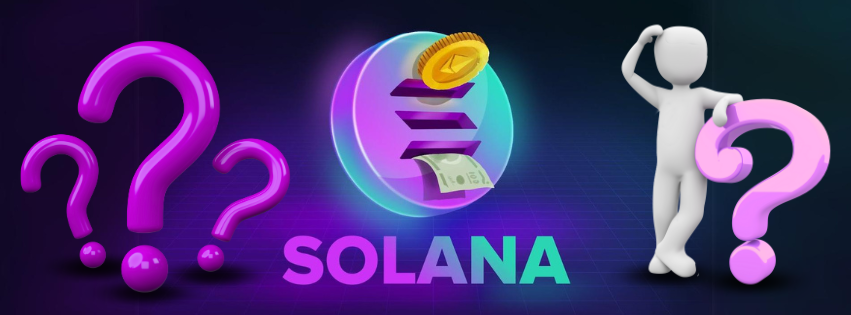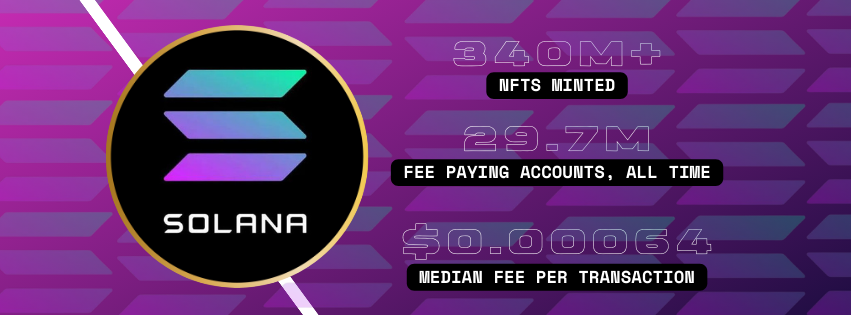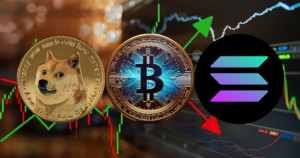The Ultimate Solana blockchain Guide, Everything You Need to Know to Get Started

What promising altcoin hasn’t been called an “Ethereum killer” at this point? Yet, out of the myriad crypto tokens and coins appearing (and promptly disappearing) every year, a few stand out. Solana is one of them.
Solana blockchain is renowned for its high efficiency and robust functionality as a smart contract platform. Its native cryptocurrency, SOL, has consistently ranked high in market capitalization and has become a favorite among many crypto investors. But what exactly is Solana, what sets SOL apart, and why has this cryptocurrency attracted so much attention?
Key Takeaways – The Solana Blockchain & Cryptocurrency:
- What Is Solana? Solana is one of the world’s leading cryptocurrencies and a widely-used blockchain network with smart contract capabilities.
- The SOL Token – SOL is Solana’s native cryptocurrency. It plays a central role in the network’s operations and economics.
- High-Performance Blockchain – The Solana blockchain is designed to support scalable decentralized applications (dApps) and cryptocurrencies with high transaction throughput.
- Unique Consensus Mechanism – Solana’s blockchain combines proof of stake (PoS) with proof of history (PoH), allowing for rapid processing and validation of transactions.
- Efficient and Scalable – Solana’s architecture allows it to process thousands of transactions per second, effectively addressing blockchain scalability issues.
- Low Transaction Costs – Solana offers much lower transaction fees than many of its competitors, making it an appealing platform for both developers and users.
- Solana vs Ethereum – Solana features faster transaction times and lower costs, although Ethereum has a larger ecosystem and a more extensive developer community.
What Is Solana (SOL)?

Solana is a high-performance blockchain platform crafted to facilitate scalable decentralized applications (dApps) and cryptocurrencies. At its core is SOL, the project’s native cryptocurrency. Diverging from many other blockchain networks reliant solely on the proof-of-work consensus mechanism, Solana blockchain utilizes a distinctive blend of the renowned proof-of-stake and a novel proof-of-history algorithm.
One of the biggest benefits of the Solana blockchain network is the wide variety of different projects built on its blockchain. In that sense, it shares similarities with Ethereum, although the world’s second-largest cryptocurrency naturally boasts a significantly larger ecosystem of apps and platforms built on its infrastructure. Still, Solana has quite an impressive catalog, and each of those projects represents one more use case for its cryptocurrency, SOL.
Here are some of the projects constructed on Solana:
- HDOKI, an entertainment ecosystem that offers crypto rewards
- Star Atlas, a fully-fledged strategy game
- ALF Protocol, a Solana-based lending dApp
- Solanart, a zero-fee NFT marketplace
what is Solana (SOL) crypto?

The History of Solana
Solana’s origins can be traced back to its white paper, which was published in 2017 by Anatoly Yakovenko. Yakovenko later teamed up with Greg Fitzgerald to establish Solana Labs. However, Solana wasn’t launched to the public until 2020 after its initial token allocation. Amidst the crypto industry’s struggle with the “blockchain trilemma” of balancing transaction costs, speed, security, and scalability, Solana emerged as a promising solution. Recognizing the demand for faster transaction speeds and lower fees, the Solana Foundation laid the groundwork for what many consider one of the most scalable blockchains.
How Does Solana blockchain Work?
Solana is an exceptionally efficient blockchain, with the capability to process thousands of transactions in a fraction of a second, achieving unmatched transaction throughput.This efficiency is achieved through using a combination of proof-of-history and proof-of-stake mechanisms.
The Solana protocol uses validator nodes to process transactions, ensuring the integrity and security of data. Validator nodes play a crucial role in the proof-of-stake mechanism.They are network participants who run specialized software, helping secure the network by validating transactions.
- Role in Consensus. Validators utilize historical records from PoH to rapidly achieve consensus. They are tasked with producing blocks and validating transactions.
- Staking is a process where a node must deposit a certain amount of SOL tokens to become a Solana validator, serving as a security deposit.The more SOL tokens a validator stakes, the higher their chance of being chosen to validate a block of transactions.
- Incentives: Validators receive rewards for validating and producing blocks. However, they risk losing their staked SOL if they attempt to validate fraudulent transactions or act maliciously against the network.
The Solana ecosystem
Similar to Ethereum, Solana’s smart contract functionality enables it to host a diverse range of decentralized applications, including decentralized exchanges (DEXs), games, and non-fungible token (NFT) marketplaces.
What Is Proof of History?
Proof of history is a consensus algorithm that functions as a cryptographic timestamp, ensuring the accurate sequencing of events on the blockchain. It functions as a decentralized clock for the Solana blockchain, allowing for a synchronized and efficient system. This innovative method reduces the need for validators to communicate excessively, resulting in faster transaction speeds.
Solana Mobile Stack
Solana’s Mobile Stack is an initiative aimed at integrating blockchain technology into mobile ecosystems. Designed to extend the capabilities of Solana’s high-performance blockchain network to mobile devices, it enables developers to build decentralized applications (dApps) that are not only scalable but also easily accessible on smartphones and tablets.
The Solana network makes this possible by leveraging its inherent strengths, such as low costs and fast transaction speeds, creating mobile applications that can handle high volumes of transactions without compromising on performance. This is particularly important for applications that require real-time updates and interactions, such as gaming, financial services, and social media on the blockchain.
What Makes Solana Unique?
Here are some of the features that make Solana stand out and have boosted its popularity as both a blockchain network and a cryptocurrency.
- High Throughput. Solana can process thousands of transactions per second, addressing the challenges many blockchains face with scalability.
- Reduced Transaction Costs. Leveraging its unique architecture, Solana offers significantly lower transaction fees compared to its competitors.
- Decentralized Network. Solana’s robust network of validators ensures a secure, decentralized blockchain, keeping it resistant to central points of failure.
- Adoption. Platforms like Solana Pay and the NFT trend have leveraged Solana’s infrastructure, further solidifying its position in the market.
Is Solana a Good Investment?
Like all cryptocurrencies, investing in Solana blockchain comes with risks. Its rapid growth, high market capitalization, and adoption by dApps and platforms like market makers signify its potential.
Solana has made a significant impact on the world of blockchain and cryptocurrency, and is currently one of the most popular cryptocurrencies worldwide. Its innovative approach to transaction validation and sequencing sets it apart from other players in the space. As with any new addition to their portfolio, potential investors should thoroughly conduct their research, consult financial experts if necessary, and make sure they understand market dynamics before making a decision.
How To Buy Solana
Purchasing SOL, the native crypto tokens of Solana, can be done on numerous centralized and decentralized exchanges – for example, Changelly. Some platforms do not offer direct Solana purchases – in that case, you can first purchase a stablecoin like USD coin, and then exchange it for SOL. Before buying, always ensure you’re using a reputable exchange and consider transaction fees, which, given Solana’s architecture, are often competitive.
Can Solana blockchain Become the New Ethereum?
Solana offers several advantages over Ethereum as a smart contract platform. With its high transaction throughput (65K on Solana compared to Ethereum’s 10-30 TPS), lower costs, and other features, it’s an excellent platform for developing various dApps. Additionally, the Solana network has introduced several improvements and innovations, such as the Turbine block propagation protocol and Tower Byzantine fault tolerance (BFT), to further enhance its scalability and efficiency.
That said, Ethereum also has its own advantages.Solana boasts an established reputation, a flourishing community, and years of experience. Moreover, it has undergone numerous upgrades, such as Dencun, which can mitigate the disadvantages of the Ethereum blockchain.
In the end, it is hard to say whether Solana will become the ultimate “Ethereum killer” or not — but even if it doesn’t, it is still a highly effective and innovative network in its own right.
Disclaimer: Please note that the contents of this article are not financial or investing advice.The information presented in this article reflects the author’s opinion and should not be construed as providing trading or investment recommendations. We do not guarantee the completeness, reliability, or accuracy of this information. The cryptocurrency market is highly volatile and subject to occasional arbitrary movements. Therefore, investors, traders, or regular cryptocurrency users should conduct thorough research, consider multiple viewpoints, and familiarize themselves with local regulations before making any investment decisions.









 Bitcoin
Bitcoin  Ethereum
Ethereum  Tether
Tether  Solana
Solana  XRP
XRP  Dogecoin
Dogecoin  USDC
USDC  Lido Staked Ether
Lido Staked Ether  Cardano
Cardano  TRON
TRON  Shiba Inu
Shiba Inu  Avalanche
Avalanche  Wrapped Bitcoin
Wrapped Bitcoin  Wrapped stETH
Wrapped stETH  Toncoin
Toncoin  Sui
Sui  Bitcoin Cash
Bitcoin Cash  WETH
WETH  Chainlink
Chainlink  Pepe
Pepe  Polkadot
Polkadot  LEO Token
LEO Token  Stellar
Stellar  NEAR Protocol
NEAR Protocol  Litecoin
Litecoin  Aptos
Aptos  Wrapped eETH
Wrapped eETH  Uniswap
Uniswap  USDS
USDS  Cronos
Cronos  Hedera
Hedera  Internet Computer
Internet Computer  Ethereum Classic
Ethereum Classic  Bonk
Bonk  Render
Render  Bittensor
Bittensor  Ethena USDe
Ethena USDe  POL (ex-MATIC)
POL (ex-MATIC)  WhiteBIT Coin
WhiteBIT Coin  Dai
Dai  Artificial Superintelligence Alliance
Artificial Superintelligence Alliance  dogwifhat
dogwifhat  MANTRA
MANTRA  Arbitrum
Arbitrum  Monero
Monero  Stacks
Stacks  Filecoin
Filecoin